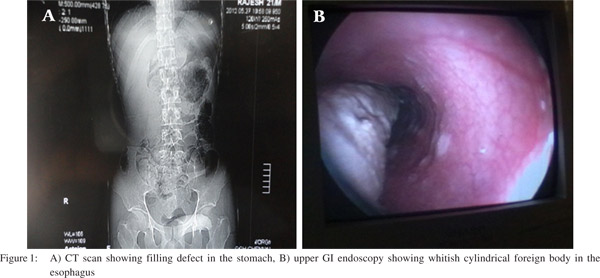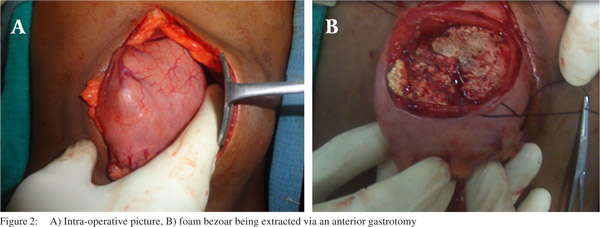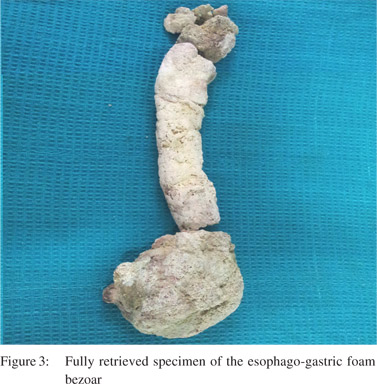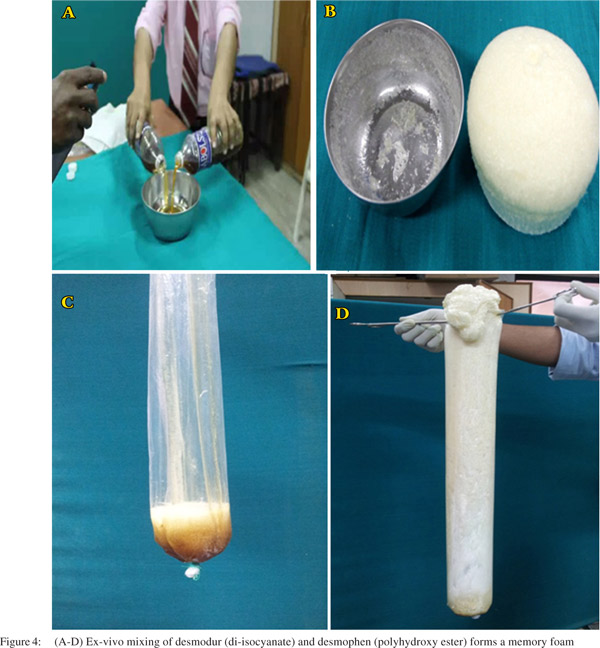|
|
|
|
 |
 |
| |
 |
|
|
Case Report |
|
|
|
|
|
Keywords :
|
|
|
SM Chandramohan1, Rathinasamy Rajkumar1, Bennet Duraisamy1, Aabalagan Amudhan1, Ragunanthanan2, Mohammed Ali3
Departments of Surgical Gastroenterology,
Center of Excellence of Upper GI surgery,1
Medicine and Toxicology2 and Medical Gastroenterology,3
Madras Medical College and Rajiv Gandhi Government General
Hospital, Chennai – 600003, India
Corresponding Author:
Dr. SM Chandramohan
Email: smchandra@yahoo.com
DOI:
http://dx.doi.org/10.7869/tg.197
48uep6bbphidvals|656 48uep6bbph|2000F98CTab_Articles|Fulltext Bezoars are collections of indigestible material like hair, vegetable or fiber, that accumulate in the gastrointestinal tract. They are encountered usually in the stomach and present with myriad complaints ranging from subtle symptoms like epigastric pain, nausea and vomiting to serious complications like outlet obstruction and perforation. We report a unique case of an upper gastrointestinal bezoar due to “foam”; possibly the first human case report of a bezoar which had taken the shape of esophagus and stomach. The bezoar was successful removed and the patient is doing well on follow-up.
Case report
A 21-year-old air conditioning mechanic was referred from our Toxicology Department with history of retrosternal discomfort, upper abdominal pain and fullness. He had attempted suicide 24 hours prior to admission, by consuming several chemical fluids used as insulation in freezers, refrigerators and for building construction.
Systemic examination was unremarkable. Abdominal examination revealed a firm, smooth movable mass in the epigastrium. X-ray chest and abdomen did not contribute to the clinical assessment. Plain CT scan of the abdomen and chest showed a filling defect extending across the esophagus and stomach (Figure 1A). Upper gastrointestinal endoscopy showed a white mass occupying the entire esophagus and
stomach. The scope could be passed along the mass up to the duodenum as it was not adherent to the wall (Figure 1B). Attempts at endoscopic removal failed. He was taken up for surgery with a supra-umbilical midline incision. There was a movable mass in the entire stomach extending into the esophagus (Figure 2A). With an anterior gastrotomy, the entire mass which was in the shape of esophagus and stomach was removed in-toto (Figures 2B & 3). The gastrotomy was closed in a single layer using interrupted 00 vicryl sutures. The patient made an uneventful recovery. Analysis of the material retrieved showed it to be a combination of agents used to prepare polyurethane foam.



 Discussion
Polyurethane polymers are formed by combining two or several bi- or higher functional monomers. When they combine by the process of condensation they form a highly resilient foam.[1] These are used for foam seating, rigid foam insulation panels, microcellular foam seals and gaskets, durable elastomeric wheels and tyres, automobile suspension bushings and many other purposes. There are two important components which constitute polyurethane foam, isocyanate and polyol. Polyurethane can be made in a variety of densities and hardness by varying the type of monomers used and adding other substances to modify their characteristics notably density or enhance their performance. In industrial practice various catalysts and polyols are used to synthesize “memory foam” which is supposed to be softer at skin temperature than at room temperature. Fully reacted polyurethane polymer is chemically inert.[2]
Discussion
Polyurethane polymers are formed by combining two or several bi- or higher functional monomers. When they combine by the process of condensation they form a highly resilient foam.[1] These are used for foam seating, rigid foam insulation panels, microcellular foam seals and gaskets, durable elastomeric wheels and tyres, automobile suspension bushings and many other purposes. There are two important components which constitute polyurethane foam, isocyanate and polyol. Polyurethane can be made in a variety of densities and hardness by varying the type of monomers used and adding other substances to modify their characteristics notably density or enhance their performance. In industrial practice various catalysts and polyols are used to synthesize “memory foam” which is supposed to be softer at skin temperature than at room temperature. Fully reacted polyurethane polymer is chemically inert.[2]
We conducted an in vitro experiment by mixing the two liquids which the patient had consumed. We found that it expanded 30 times its initial volume over a period of 3 minutes, became hard and took the shape of the container used (Figure 4). The external temperature during the reaction, measured using an industrial thermometer was 94°C. But it did not cause any thermal injury to our patient’s esophagus or stomach and it solidified taking the shape of the esophagus and stomach. Extensive literature search did not reveal any similar report involving the esophagus and stomach. There is one case of rectal impaction by epoxy resin following self administration of a liquid used as masonry adhesive for anal sexual gratification.[3]
References
- Wikipedia, The Free Encyclopedia [Internet]. Polyurethane; [cited 2012 Dec 14]; [about 18 screens]. Available from: http://en.wikipedia.org/w/index.php?title=Polyurethane&oldid=527792082
- Seymour RB, Kauffman GB. Polyurethanes: a class of modern versatile materials. J Chem Ed. 1992;69:909.
- Hemandas AK, Muller GW, Ahmed I. Rectal impaction with epoxy resin: a case report. J Gastrointest Surg. 2005;9:747–9.
|
|
|
 |
|
|